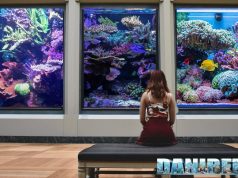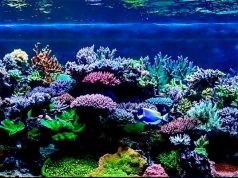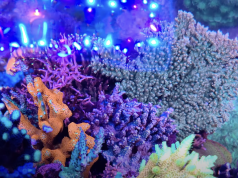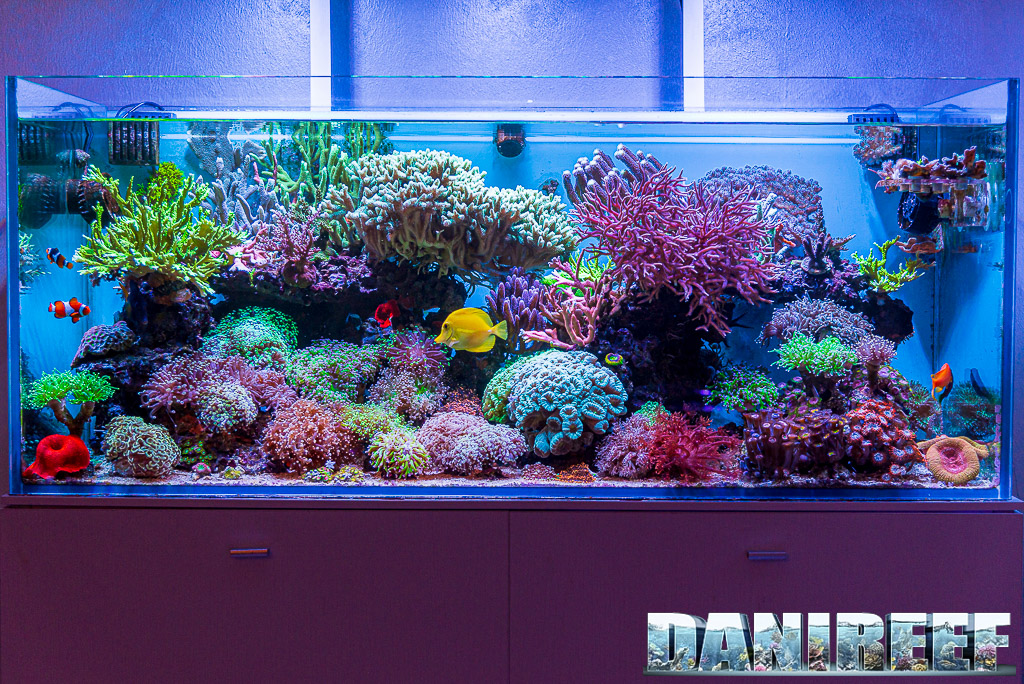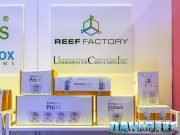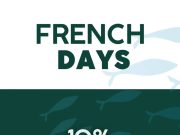
I always loved drop-offs in aquariums. And Federico Lavezzi‘s tank hits you as soon as you enter his house. Spectacular.
This article is also available in: italiano
We’ve been at Federico’s some Saturday ago and the moment we came in we stand speechless. The drop-off gives the aquarium an unusual shape, but it’s amazingly harmonious and with a lot of movement, created by the soft corals, the gorgonia and the fish inside. We really loved it, and if you too want to see its dynamism watch the video below!
We chose that picture of the opening for a reason. We usually watch the aquariums by standing in the front, but this time we can also appreciate the tridimensionality of the setting with a three-quarter photograph.
Federico’s aquarium is dynamic, addictive, we really liked it.
Before leaving you to the pictures, don’t miss the video we did for you!
The video of the drop-off aquarium of Federico Lavezzi
Federico’s aquarium is really incredible. Especially because it doesn’t require who knows which stratospheric equipment! All considered, this aquarium can even be cheaper than others with hard corals! But the best features are the passion and the care that Federico invested in it. Our best congratulations for what he managed to create.

The interview with Federico
Hi Federico, we’re glad to be here with you admiring this absolute jewel. Would you tell us its history?
It feels like a lifetime since I received my first aquarium when I was 10. Since then, I remember I always had at least one aquarium in my home, except for short periods. I started with fresh water and I tried a little bit of everything, from Guppy to the breeding of Discus. At time there where very few informations about, you blindly trusted the shopper (luckily I’ve always found honest and prepared people) and, if you were lucky, you could find a book on the topic.

I watched marine aquariums with a certain awe. In 2012 I decided to set my first nanoreef and there a world has opened to me. I like to study and understand things, so I educated myself through books and internet. That is how I first met DaniReef and found out that not only there are the website and forum, but also a group of people next to me that share the same passion for aquaristics… finally (the MagnaRomagna ndr)! I grew a lot by comparing with other aquarists, discovering their tanks, discussing about settings and techniques.

The idea of the drop-off
Federico, tell us about how was born the idea of making such a particular aquarium. I obviously refer to the drop-off.
The actual tank, as you see it, has born in 2019 by the mood of doing something unusual. The first idea I had was exactly the drop-off and I started projecting everything, knowing that I would have to create it by hand, so I studied how to make the composition harmonious and chose the fish it would have hosted (I live at the first floor, so I can’t exaggerate with the liters!).

For creating the tank and the forniture I have to thank my friend Luis of Artico di Tavullia, a passionate aquarist and member of MagnaRomagna, that helped me also with the transition from the old tank to the new one.

The glasses are all extraclear of 12 mm, 105 cm of length (65 + 40 of drop) x 60 of depth x 75 of height (45 cm in the short part) for a total of about 324 litrers. Add then the sump of 58x40x40h with a bulckhead that maintains the level costant to 22 cm.
The technical part of the drop-off aquarium of Federico
The sizes, in fact, aren’t that wide, but the aquariums seems much bigger than what it is. A really beautiful visual effect. And what else can you tell us about the technical part?
The maintenance of the aquarium is based on the berlinese method, so I set a big rock (almost 40 kg, all ripe and recovered from the last tank), a powerful skimmer, the Nyos Quantum 160 and the carbon. I make water changes every two weeks of 30 liters (about the 10% of the whole volume). This allows me to keep the values of the pollutants low, although the tank is pretty populated. The rest of the technique is below:
- Movement: Two pumps Rossmont Mover, one of 5800 l/min and the other 4600 l/min, one on the opposite side of the other, controlled by the Rossmont Waver and a Jebao SW4 on the bottom of the drop oriented towards the top in order to avoid stagnation.
- Load and drain: UltraReef
- Lighting: two ceiling lights Orphek Ocean
- Return: Hydor Seltz D6000 electronically controlled
- Refill: WaveReef
- Fluidized bed reactor: Forwater, mainly used for carbon and, at use, for resins
- Skimmer: Nyos Quantum 160.

For about 6 months I have adopted the integration protocol ATI Essentials Pro with dosometric pump with four channels by JoyReef. I have to say I’m very fond of both. The dosometric is very precise and with an intuitive software. The calculation of the quantities is simplified by the program that ATI made available on its website. In short, the dose are correct and sometimes I even forget about the tank. The values stay still, and the aquarium benefits from it.

Even if I’m not that technology enthusiast, I think that the possibility to automatize as much as possible some utilities allows to reduce the burden of the whole maintenance, that otherwise would be too expensive in terms of time, leaving to the user the pleasure to enjoy the tank.

The fish
What guided your choices for the number and the typologies of the fish?
I wanted to recreate a glimpse of a reef trying to keep it as natural as possible, so I needed all lot of fish and with many colors. I didn’t have the necessary dimensions for large fish, so I focused on shoal fish and small fish with a pacific nature. This is the actual formation:
- a couple of Amphiprion ocellaris that I carry with myself since the first marine tank that often lay eggs;
- 5 Pseudanthias squamipinnis;
- 12 Chromis viridis;
- 9 Chrisiptera springeri;
- 1 Oxycirrythes typus, 1 Pseudochromis fridmani, 1 Ecsenius bicolor, 2 Gramma loreto, 1 Acanthurus olivaceus, 1 Pterapogon kauderni;
- I also have many invertebrates: 1 Lysmata amboinensis, 1 Lysmata debelius, 1 riccio Diadema setosus, 1 hermit crab Calcinus elegans, an uncountable number of turbo snails.

And for the corals?
Why this particular choice of corals, a bit upstream, that focuses on soft and hard corals with long polyps (LPS)?
I think that, in order to return the idea of nature, the tank has to be in movement. For this reason I manly chose soft corals and LPS, gorgonia in particular, which I really like, and the anemone that have a symbiontic relationship with clownfish.



Even for corals I followed the same chromatic choice of the fish: a rainbow of colors that creates an harmonious whole. Actually in my tank there are: 3 Entacmaea quadricolor, 1 Fungia, Euphyllia glabrescens, Euphyllia paradivisa (of 2 differrent colors), 1 Pavona cactus, 1 Caulastrea furcata, 1 Blastomussa, 2 Acanthastree, 1 Catalaphyllia jardinei, 1 Lobophylia, various Sinularie (green and purple), several Zoanthus (Pink, Rasta, red and green), several Discosoma and Rhodactis, Briareum and obviously the Gorgonia (Pseudopterogorgia, Gorgonia ventalina and others).

The whole aquarium returns a great harmony to the viewer. We really enjoyed taking pictures and shooting the video, through which it can be mostly appreciated the peculiarity of this aquarium.

Where are we now?
The tank, after two years and a half, I think reached its apex: the corals have grown big and now occupy almost all the space available, so much that in some cases they itch each other… So I think I should thin some pieces.

I’m very satisfied with the whole setting. I have to say I reached an equilibrium for values in the tank and the cohabitation of the animals. I don’t detect any sign of stress in the fish, if you don’t count some small fight every now and then… but I think it’s in the same nature of the animals. A big thank to DaniReef for giving me the opportunity to show my tank and also to my friends of MagnaRomagna with which I share this wonderful hobby, and who are always ready to share suggestions and help!

DaniReef’s comment
You will have understood for sure what I think of this drop-off aquarium. It’s amazing. You have to appreciate its harmony and dynamism in real life or in video, because the movement is its strong point.

Technically speaking the system is very well done, without any weak point, I think. The drop-off has a volume of more or less 300 liters. The skimmer, the Nyos Quantum 160 that we tried some years ago, is perfect for this type of aquarium, with soft corals and LPS. The return pump, the Hydor Seltz D6000, that we also reviewed some years ago, is perfect, in fact we would like to suggest it even for bigger systems with more performing skimmers. The movement is managed by a couple of Rossmont Waver that guarantee alone a movement equal to 15/20 times the liters, plus the help of the Jebao SW4 on the bottom of the drop that avoids stagnations. The ceiling lights are a couple of Orphek Ocean, which Orphek produced for a very short period, that substain the system with 130 watt each.

Even the choice of the fish really suits the purpose of the aquarium, apart, maybe, the Acanthurus olivaceus, that I’m afraid it could be a bit sacrified, even if the drop helps to give it more movement. The shoals together are beautiful, maybe a few more Chromis or Pseudanthias could find place. What do you think?

And what do you think?
What do you think of a drop-off aquarium? Do you like it? Tell us your thoughts in the comment section or on our social. On Instragram you’ll find our daily updates! Let’s continue on page two for all the amazing pictures of Federico’s fish and corals!







